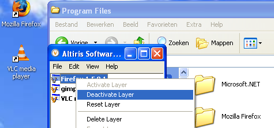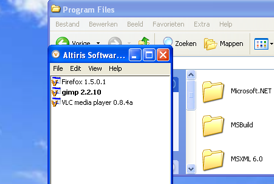Current Application Virtualization solutions
As it is, there are four major players in the application virtualization market. There are probably dozens of others available, but the focus appears to be on these four that - because of their slight differences - cover most of what is currently desired.
Microsoft Application Virtualization
Acquired by Microsoft in 2006, this software may sound more familiar by naming its previous versions: Softricity's SoftGrid or Microsoft SoftGrid. MAV is pretty much a nice average of everything we've just described, developed by Microsoft to strengthen their position in the virtualization market. It uses a classic client/server model, using the Microsoft Systems Center Virtual Application Server to host the applications and provide them to the client through streaming. It allows for advanced user authorization requirements in order to deal with licensing issues, and it is able to stream selectively. This means that if a user only makes use of certain libraries within the application, only those libraries need to stream to the specific system.
Using MAV in a streaming environment prevents any of the applications from actually being installed on the client computer (apart from the user's local settings). While the application code can remain cached on the system, it will not function like a regularly downloaded piece of software, it remains dependent on MAV to be able to run and can be managed remotely. MAV does provide the option to run virtualized apps locally without the use of streaming, should the need arise.
XenApp
Known by many as simply Citrix, XenApp is the new name of what was previously Citrix Presentation Server. This software generally caters to a different audience, its focus being primarily applications that are run on the remote server with the interface then streamed to the user, as opposed to running the application on the client side. However, Citrix has included the possibility for application virtualization for quite a while, and with this new release it is pushing both server-side and client-side virtualization to the foreground. While this move more or less forces the software into direct competition with MAV, Citrix has stated that it believes several separate developments of the technology will increase customer awareness of its merits, and the interoperability of Citrix and Microsoft technologies will continue playing a big role in improving the user experience.
SVS
Acquired by Symantec in 2007, Altiris provides a very solid application virtualization solution with SVS. SVS (Software Virtualization Solution) adds an interesting twist to the story by introducing a slightly different look at the isolation of the applications. Instead of completely isolating separate applications, it gives users the opportunity to build up their own custom "layers". This removes the restriction to pure software virtualization and allows us to virtualize pretty much anything in the file system; it also enables users to bundle different applications in a single layer, allowing them full communication with each other when necessary. Activating a layer will make the contained application look as if it's installed normally, complete with its folder and files being present in the Program Files directory, while deactivating a layer removes every trace of the application from the system.
While making all the files available to a user does make an app more vulnerable to user errors, these problems are easily resolved by a simple reset of the application in the SVS Admin. SVS allows for streaming software in a similar fashion as MAV, using a central SVS Client Management Suite.

One moment, Firefox and VLC player are there, and present in the Program Files...

The next, they've disappeared from the system completely!
Thinstall
Though Thinstall may be the odd one out in this comparison, it is still a very capable product with an interesting approach. Acquired by VMware in January 2008, Thinstall is different from other solutions in that it is "agentless". This means that virtualization is achieved without the need for any management software on the client, essentially making the packages useable on any computer running Windows. This is done by installing the Thinstall software on a freshly installed operating system and using it to capture the installation of any piece of software. After making the necessary changes in settings, Thinstall will compile the entire application, along with its extremely lightweight agent, into a single distributable package. This takes the portability of the software to a whole new level, allowing applications to be carried pretty much anywhere on a simple USB stick. Of course, this portability raises questions about controlling software after deployment.
It is possible to keep these "thinstalled" applications together in a single repository (i.e. a shared network drive), allowing people to stream them by simply opening them from that location. However, the technology seems a bit limited by its own portability in that respect. The potential for licensing issues and/or piracy of products is also a potential concern. Nevertheless, Thinstall remains a very convincing product, especially well suited for businesses looking for true, transparent portability of even the largest software suites. Now that VMware owns the software, we're excited to see how the package develops in the future.










11 Comments
View All Comments
DigitalFreak - Monday, February 25, 2008 - link
But not unintelligent, like yourself.